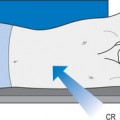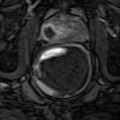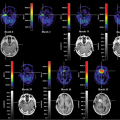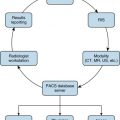Section 3 Contrast media
X-ray
However, if two organs have similar densities and similar atomic numbers, as in the contents of the abdomen, no natural contrast exists and therefore they will not be individually visualised on a radiograph. A limitation of all plain x-ray examinations is that most of the soft tissue structures of the body are of similar radiographic density. It is therefore necessary to introduce a substance into the body that will increase the radiographic contrast of an area where previously contrast was low or absent. This is achieved by altering the density and the average atomic number of the area under investigation. The development of contrast-enhancing agents has made it possible to visualise an organ, the surface of an organ or the lumen of an organ that would not normally be visible on an x-ray image.
Desirable features of contrast media are numerous, the most important being to ensure that they are not detrimental to patient well-being. They should cause negligible distress to the patient on introduction, no adverse reactions post introduction and no permanent alteration to the organ they target. They must be easy to administer and remain stable within the body so as not to dissociate into toxic ions. Once in the body they need to concentrate in the intended area and remain unchanged by, for example, organ contents, in order to allow that organ to be accurately demonstrated. Viscosity of the contrast medium on introduction is significant to both patient comfort and the success of the procedure being carried out. Elimination should be rapid. Cost should not be prohibitive to their use.
Positive contrast media
These are either barium or iodine based and radiopaque as a result of their ability to attenuate the x-ray beam. Positive contrast media increase the atomic number of the areas they are being used to demonstrate relative to the surrounding tissue. The contrast medium absorbs the x-rays and the organ under investigation appears radiopaque on the resultant radiograph.
Barium
| Advantages | Coming in various forms from the manufacturers, it is available ready-made in cans, as a powder to which water is added, as aerated liquid preparations and ready-prepared in plastic bags for specific examinations. A relatively inexpensive medium, it has excellent coating properties with flexibility of use as a result of the differing concentrations available, dependent on its dilution with water, for the region of the GIT under examination. Double-contrast examinations of the GIT use air or carbon dioxide as the second contrast medium. For the upper GIT this is generally in the form of gas-forming granules and room air is used for the lower tract. A double-contrast study gives optimal mucosal detail and avoids small anomalies being concealed by large volumes of positive contrast media. |
| Disadvantages | One practical disadvantage of using barium sulphate is that subsequent examinations may be difficult as once in the intestinal tract it takes time to clear. |
| Precautions | Adequate hydration of the patient post procedure is recommended. |
| Contraindications | If a perforation of the bowel is suspected the use of barium sulphate is contraindicated as its presence in the GIT can cause, along with pain and shock, a chemical peritonitis which can prove to be fatal in extreme cases. In these circumstances or where there is a suspected sinus or fistula, water-soluble contrast media should be used. The same applies in the upper GIT should a perforated ulcer be suspected. |
Iodine
Iodine-based contrast agents are the largest group used in medical imaging. Although there are other elements with higher atomic numbers, iodine is suitable as a radiographic contrast medium because it is the only one with chemical characteristics that allow it to develop into soluble compounds that have low toxicity. There are numerous brands on the market with each one prepared for specific use(s) and for the most they are used intravenously. The exception is Gastrografin, a water-soluble iodinated contrast medium for oral administration.
| Precautions | The rate of adverse reactions to intravascular iodinated contrast media is relatively low but certain patient groups show a greater predisposition. The Royal College of Radiologists6,7 has identified those they consider to be at a higher risk of having adverse reactions. These highrisk patients include those:Stay updated, free articles. Join our Telegram channel
Full access? Get Clinical Tree
 Get Clinical Tree app for offline access
Get Clinical Tree app for offline access

|




